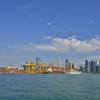ABS Preliminary Approval to 2nd OGT Concept
ABS has now issued an Approval in Principle (AIP) for a second floating Gas to Liquids (GTL) concept and is currently involved with the review of several additional GTL concepts from leading energy operators.
ABS provided its first AIP for a GTL concept (a floating production barge facility) in 2006. Since then, it has seen a steady increase in the number of requests it has received from designers for the review and preliminary assessment of proprietary technologies that have been developed for floating GTL facilities. The identity of the operator behind the most recent AIP remains confidential given the commercial opportunities this new technology may open up.
Currently there are no GTL plants offshore and operators are looking to ABS to provide technical guidance for the marinization of this technology which is currently used in shore-based projects only. “The marine environment, dynamic loads, impact of sea motions and equipment congestion on the floating structures can be significant for GTL plants. The high temperature and explosion risk of GTL plants need special attention” said Harish Patel, Manager, Emerging Technologies, ABS. “Depending upon the technology selected and the intended location of the facility, technical concerns need to be fully addressed.”
ABS is well positioned to take a holistic approach to the review of GTL concepts, including the application of risk methodologies. It is able to draw on its experience with all current forms of natural gas handling, including LNG and CNG, as well as offshore production units in assessing these proposed facilities.
According to Patel, the emerging trend is the use of small scale, compact GTL plants offshore. By placing the GTL plant on an existing FPSO, associated gas that would have previously been flared or reinjected, can now be converted to a clean, low sulfur petroleum product or can be blended into oil, transferred using conventional FPSO handling systems and shuttled ashore using readily available product tanker tonnage. Key to making this happen is to test minimal scale GTL plants onshore to verify technology and identify all potential risk. Furthermore, he says, the projects are scalable, allowing for design optimization and tailoring for stranded marginal or smaller gas deposits opening ways to commercialize those fields.
It is estimated that more than one-third of global gas reserves are stranded by their location or field size.














